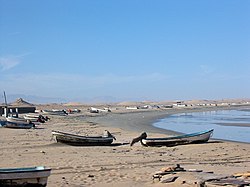Qalhat
| قلهات Qalhat |
||
|---|---|---|
|
|
||
| Coordinates | 22 ° 42 ' N , 59 ° 22' E | |
| Basic data | ||
| Country | Oman | |
| Janub al-Sharqiyyah | ||
| ISO 3166-2 | OM-SJ | |
| height | 10 m | |
| Residents | 1123 (2010) | |
|
The Bibi Maryam mausoleum
|
||
Qalhat ( Arabic قلهات, DMG Qalhāt ) is a settlement in northeast Oman . In earlier times, this was an important trading center for trade between the Arabian Peninsula and India.
Location description
The place is located in the south of the governorate of Dschanub al-Sharqiyya in Wilayat Sur , about 20 kilometers north of the city of Sur in present-day Oman. The settlement is located on a plateau about 10 meters above sea level and had 1123 inhabitants according to the 2010 census. To the west it is bounded by mountains, to the north by the sea and to the northwest by a valley and alluvial land ( khaur ). The city occupies an area of 35 hectares and the north-south extension is about 1 kilometer. The city is surrounded by the remains of earlier fortifications (walls, towers).
The port of Qalhat, Qalhat LNG Terminal or Port of Qalhat , is located just outside the town on a 1.4 km² site. A main loading port for liquefied gas from the gas fields of Oman is located here. Investors from Japan and Korea in particular are involved in the port expansion.
One of the landing points of the international sea cable SEA-ME-WE 5 is located in Qalhat .
history
Historically, Qalhat was an important trading center on the Arabian Sea in the period before 1500 . From here sea routes went to India, Yemen and the Persian Gulf . In essence, the place functioned as an intermediate trading post for trade between India and Arabia. Qalhat was the second capital of the Sultanate of Hormuz, which controlled access to the Persian Gulf on the Strait of Hormuz for several centuries from around 1300 to 1508 . In its heyday, the sultanate controlled many cities on the southern coast of Arabia, including Qalhat, Qurayyat , Muscat, and Sohar . Qalhat was known as a trading center far beyond the region and was mentioned as such by European and Arab travelers in their writings, including Marco Polo (1254–1324) and Ibn Battūta (1304–1377). The latter had also personally visited the city between 1328 and 1330. Racehorses , dates , pearls and salt came from Arabia as trade goods, while cloth, metalwork, spices and rice came from India.
The end of the heyday of Qalhat and the entire Sultanate of Hormuz came with the arrival of the European colonizers. In 1505 the Portuguese navigator Afonso de Albuquerque had signed a kind of friendship treaty on his first visit. However, the Portuguese returned as early as 1508, plundered and destroyed a large part of the city and in the following years also brought the entire sultanate under their control. The main motive for this was the endeavor to bring the lucrative spice trade between India and the Ottoman Empire under control. To this end, the Portuguese established an extensive network of trading posts and fortified squares on the shores of the Indian Ocean and fought competing Arab-Ottoman trade. Qalhat did not recover from the destruction in 1508 and the trading center then relocated to Muscat.
Inclusion in the world heritage
At present, some buildings and ruins still bear witness to its former importance. The most important architectural monument is the mausoleum of Bibi Maryam. The mausoleum is built in the same style as similar buildings from the same period in Iran and Central Asia and was built by the Sultan of Hormuz and ruler of Qalat, Bahauddin Ayez for his wife Bibi Maryam.
On May 23, 2013, the Omani government applied to UNESCO to register the historical sites as World Heritage. The reason for the application was that the most important remains of a sea trading center in southern Arabia for overseas trade can be found in Qalhat. The place was included in the so-called tentative list of UNESCO and declared a World Heritage Site in June 2018.
Web links
- Entry on the UNESCO World Heritage Center website ( English and French ).
- The Historical City of Qalhat , description of the historical sites on the Omani Ministry of National Heritage and Culture website
Individual evidence
- ↑ Qalhat (Ṣūr). citypopulation.de, 2010, accessed on November 20, 2016 (English).
- ↑ a b c d e Ancient City of Qalhat. UNESCO, May 23, 2013, accessed November 20, 2016 .
- ^ Oman LNG LLC> The Company> Key Fcts. Retrieved November 20, 2016 .
- ↑ SEA-ME_WE-5. Retrieved November 20, 2016 .
- ↑ https://whc.unesco.org/en/news/1844/



